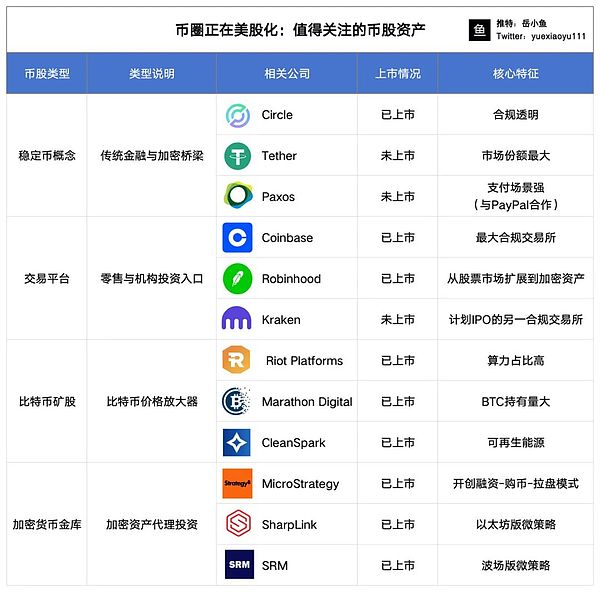The cryptocurrency world is gradually becoming like the U.S. stock market. Now you need to understand the U.S. stock market to play in the cryptocurrency world.
Because Bitcoin has an ETF, originally only Bitcoin and the U.S. stock market were very close, but now people in the cryptocurrency industry are starting to make things happen in the U.S. stock market.
Let's take a look at what "coin stocks" are worth paying attention to at present?
The entire coin stock market is mainly divided into 4 categories:
The first category of stablecoin concept stocks, the benchmark is Circle.
However, Circle's current premium is very high. People in the currency circle can't understand it, but people in traditional finance are still rushing in.
In addition to Circle, other companies worth paying attention to include Tether (a non-listed company, but USDT dominates the market) and Paxos (issuing Pax Dollar and PayPal USD).
The second category is trading platforms, with Coinbase as the benchmark.
However, Coinbase's assets are already priced too high, with stable valuations and limited room for growth.
In addition to Coinbase, Robinhood and Kraken are also worth paying attention to.
Robinhood itself is a traditional stock trading platform, but it is actively expanding into cryptocurrency and has just acquired Bitstamp.
Kraken is also a US compliant exchange that has not yet been listed and is planning an IPO. If the IPO is successful, it will be a strong challenger to Coinbase.
The third category is mining stocks, which are engaged in the Bitcoin mining industry.
Typical representatives are Riot Platforms (RIOT), Marathon Digital Holdings (MARA), and CleanSpark (CLSK).
Mining stocks are cyclical stocks, with large losses in the bear market and high returns in the bull market.
Due to their reliance on computing power and energy costs, they will be under pressure from environmental protection policies.
In the long run, the improvement of Bitcoin's reserve asset status is still good for mining stocks.
The fourth category is the cryptocurrency vault, represented by MicroStrategy.
MicroStrategy pioneered the "financing-purchasing-pull-up" model, raising funds from the market and buying BTC with leverage.
Currently there are Ethereum MicroStrategy, Solana MicroStrategy, TRON MicroStrategy, etc.
Many leading cryptocurrency companies are buying some US stock shell companies, then raising funds from the US stock market and reversely purchasing cryptocurrencies.
This is a great test of the financing ability of cryptocurrency companies, which need to have money themselves, such as MicroStrategy.
For example, SharpLink bought by the Ethereum core circle and SRM bought by Sun Yuchen of TronEntertainment.
However, these two are different. The former is to raise funds from the market to buy Ethereum, while the latter is to inject the stablecoins and TRX in his hands into this US stock company, and then withdraw the funds into US dollars.
Therefore, assets such as SRM may have potential compliance risks.

To sum up
Stablecoins and trading platforms represent "infrastructure" investments, while mining stocks and cryptocurrency vaults are more like "high-risk, high-return" speculative assets.
The risks of these four types of cryptocurrency stocks are different:
(1) Stablecoins have the lowest concept risk, but their growth ceiling is limited, and they are suitable for institutional investors who pursue stable returns.
(2) The trading platform has a high valuation and needs to pay attention to the ecological expansion capability. It is suitable for investors who are optimistic about the long-term growth of the crypto market.
(3) Mining stocks have strong cyclicality and need to pay attention to energy and regulatory pressure. They are suitable for cyclical traders, but they need to adjust their positions dynamically based on Bitcoin prices and energy costs.
(4) Cryptocurrency vaults have the strongest explosive power, but also the highest leverage and regulatory risks. They are suitable for speculators with high risk preferences and need to conduct in-depth research on the company's financing capabilities.
Coins and stocks are merging, with stock assets being put on the chain and coin assets being listed, and the liquidity of the two markets is being opened up in both directions.
 Catherine
Catherine







